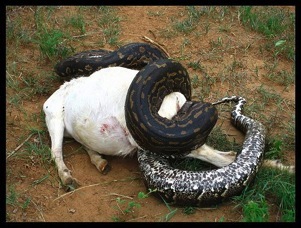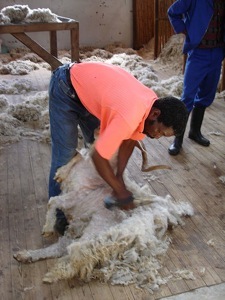Interactions with other Species

“Friend Or Foe?”
Capra hircus has many interactions with other
species. As a grazing herbivore, it acts as the
prey of many animals such as coyotes, dogs,
mountain lions, foxes, eagles, large snakes, and
bobcats. Domestic goats often gain protection
from these predators through fences built around
their grazing areas. Feral goats must depend on
self-defenses, such as herd-life and horns, and
adaptations, such as horizontal-slit pupils and
their ability to eat quickly, for protection.
For more information on goat adaptations,
see Adaptations.
The goat also serves as a host for many parasites. Goats have a low immune response to many parasitic nematodes that infect the gastrointestinal tract. Some of these nematodes include Haemonchus contortus, Trichostrongylous colubriformis, Teladorsagia circumcincta, and Teladorsagia vitrinus. The goat ingests the larvae of these nematodes and then they reproduce within its gastrointestinal tract. Later, the goat excretes the eggs in the fields where it will eventually eat, and the cycle continues. The nematodes pose a major pathological threat to goats.
Also, goats are known to have a competitive relationship with many other organisms. Due to their ability to utilize a large range of food sources, goats can threaten other species ability to graze. On many islands, such as the Galapagos Islands off the western coast of South America, Capra hircus is considered an invasive species because it eliminates the food and habitat of native species. By overgrazing areas on these islands, goats can cause ecosystem degradation. On such islands, feral goats are often shot to help reduce the impact on the native species.
For more information on goats as an invasive species, see the Global Invasive Species Database.
In addition, goats have interaction with humans. Goats are
produced domestically for their meat, milk, wool and fur.
These products bring in a large amount of revenue for the
producers. In a negative sense, goats can pass diseases
along to humans who have associations with them. Some
of these diseases include rabies, toxoplasmosis,
tuberculosis and brucellosis.
To return home, click here.
To learn some more interesting facts about goats, click here.

The life cycle of Parasitic Nematodes within Capra hircus.
Image created by Kristin Brown
A python constricts a goat, its prey.
Photo by mango atchar
A goat being sheared to harvest its fur.
Photo by the Raz


